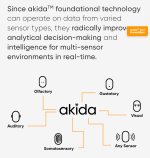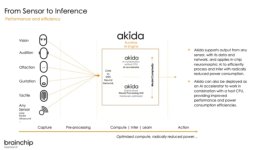Maybe, just maybe, we’ll find out a teeny-weeny bit more about the current status of MB’s neuromorphic research later this week:
I checked out the website of Hochschule Karlsruhe (Karlsruhe University of Applied Sciences aka HKA) - since Markus Schäfer mentioned in his post they were collaborating with them on event-based cameras - and discovered an intriguing hybrid presentation by Dominik Blum, one of MB’s neuromorphic researchers, titled “Intelligente Fahrassistenzsysteme der Zukunft: KI, Sensorik und Neuromorphes Computing” (“Future Intelligent ADAS: AI, Sensor Technology and Neuromorphic Computing”).
The upcoming presentation is part of this week’s
Themenwoche Künstliche Intelligenz, a week (Mon-Thu to be precise) devoted to AI, with numerous, mostly hybrid presentations from various HKA research areas (both faculty and external speakers will present), held daily between 5.15 pm and 8.30 pm.
Oct 17 is devoted to the topic of AI & Traffic:
KI, AI oder Artificial Intelligence - es ist die Technologie der Zukunft. Wir laden zu einer wegweisenden Veranstaltung ein. Erhalte eine realistische Bestandsaufnahme zum Einsatz Künstlicher Intelligenz in den Bereichen Gaming, Klimaschutz und autonomer Systeme. Wo geht die Reise hin und worauf...

www.h-ka.de
View attachment 71031
View attachment 71032
If you speak German (or even if you don’t, but are nevertheless interested in the presentation slides) and live in a compatible time zone, you may want to join the following livestream on Oct 17, at 5.15 pm (CEST):
(Since similar June
AI Day presentations were recorded and uploaded to the HKA website, I assume this will also apply to the
AI Week presentations.)
View attachment 71025
View attachment 71026
The reference to NMC (neuromorphic computing) being considered a “möglicher Lösungsweg” (possible/potential solution) suggests to me - once again - that Mercedes-Benz is nowhere near to implementing neuromorphic technology at scale into serial cars.
View attachment 71027
View attachment 71028
Here’s the link to the livestream’s recording (in German):
The presentation by Dominik Blum (Mercedes-Benz) starts at 3:48 min.
There was one slide that showed - amongst other things - various brands of neuromorphic hardware (ABR, BrainChip, Innatera, Intel, SynSense), including Akida 1.0 and 2.0, but none was mentioned by name. Same with the slide showing the EQXX: there was merely mention of the voice assistant’s keyword spotting having been realised on “a neuromorphic chip”, which was said to have considerably improved this function’s energy efficiency.
Please note that the slide showing neuromorphic hardware also lists the ABR Time Series Processor (TSP1), developed by Applied Brain Research, the Canadian company Chris Eliasmith co-founded and is CTO of (see the link to my previous post below).
I reckon TSP1 is what MB are going to base their future research on regarding their recently announced collaboration with the University of Waterloo.
So just as I said the other day, that announcement is highly likely no reason to celebrate for BRN shareholders:
https://thestockexchange.com.au/threads/brn-discussion-ongoing.1/post-438892
In the Q&A session afterwards, Dominik Blum was asked whether the architecture of neuromorphic chips resembled that of GPUs or whether it was a completely different design. His answer was: “Da wir uns mehr auf die softwareseitige Entwicklung von “neuromorphic” fokussieren, kann ich da keine gute Antwort geben.” (“Since we are focussing more on the software side development of neuromorphic, I can’t give you a good answer to that question.”)
He was also asked whether he could quantify the potential energy savings of neuromorphic computing and said that there were vague estimations of up to 90%, however, he’d be careful with any concrete numbers (suggesting 90% might actually be too high) and stressed that they are still at a very early stage of research and that further studies were required.
When asked how long it would take for fully autonomous cars to become reality, he replied he would prefer to answer as “a private person” (= not as an MB employee) and then said he believed it would be within the next 15 years, but there were various uncertainties to factor in. He wriggled for an answer when asked whether any legal framework could pose a problem regarding that time frame.
To me the gist was that while MB considers neuromorphic computing a very promising technology regarding gains in energy efficiency (which will become more and more important on the path towards cars becoming fully autonomous), they are still at a very early stage of research - Dominik Blum literally said so. There you go, you heard it from the horse’s mouth. So don’t expect neuromorphic technology in any MB serial production cars in the near future. At least that’s what I took away from that presentation.
Anything major I missed?
Here are some of the presentation slides:
Energy consumption increases with the vehicle’s number of AI-based systems:
The higher the SAE-Level, the higher the energy consumption:
Neuromorphic computing is a young field of research … with a lot of open questions, e.g.:
SNNs in the event chain of autonomous driving:
This slide kind of looked familiar…

Dominik Blum said that they are still in the research phase as to event-based cameras that will one day complement regular cameras, radar and LiDAR…






